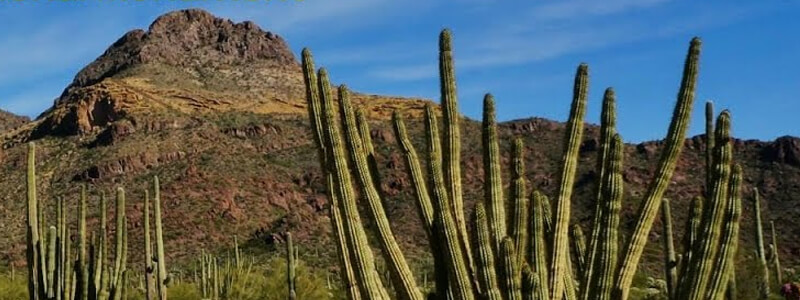Organ Pipe Cactus National Monument – Ajo, Arizona
The Organ Pipe Cactus National Monument was founded to celebrate the life and landscape of the Sonoran desert.
Whether you want to hike, take a drive on a lonely road, backpack, camp in the desert or just soak in the warmth and the beauty of the Southwest this is the place to do it.
There are extraordinary plants and animals in the Sonoran Desert for you to enjoy. These creatures adapted themselves to the extreme temperatures, intense sunlight, and little rainfall of this Southwest region. There are Twenty-six species of cactus living here, including the beautiful park’s namesake and the giant saguaro.
Because this is a protected area, Organ Pipe Cactus National Monument has allowed the life of the Sonoran Desert to flourish under nearly ideal wilderness conditions. It is one of the Earth’s major ecosystems. In 1976 it was designated as an International Biosphere Reserve.
The park is home to the Gila Monster, one of only two species of poisonous lizards found in North America. They are out in the late spring through early autumn at the park but they move really slowly so you don’t have to worry about getting away from them to avoid getting bitten. They just want to be left alone.
The area also has ferruginous pygmy owls. They are so darling, such a delight to watch (please don’t try to touch or catch them, leave them to beautify the area in their natural habitat). There are also Sonoran Pronghorns. This edgy, skittish, and shy creature will run if it hears a car as far away as 2 miles! The Sonoran pronghorn is tinier than its more extroverted grassland sibling, the American pronghorn. This desert subspecies can freeze, invisible in the patchwork of cactus and rock. Fear is their survival strategy. It steers them away from highways, automobiles, and noisy humans. It makes them fast. It keeps them wary.
With the dry season of 2002, many of them died leaving just 25 in the United States. The program to save them was begun in 2004 as scientists started a captive breeding program. 11 animals were caught, some from the larger herd in Mexico, to provide for genetic diversity. A square mile of the desert was set aside in a non-wilderness are of Cabeza Prieta National Wildlife Refuge and through the care and hard work of the scientists involved the herd has begun to grow again. They seem to adapt to the wild very well once they are turned loose as they get big enough.
Coyotes are highly intelligent animals that are well adapted to survive in almost any environment. They are among the most common animals spotted in Organ Pipe Cactus National Monument and you might hear them “singing” on any given night.
The Organ Pipe Cactus National Monument is also a fabulous place for bird watching. There are a number of great sites to sit and watch for the bird you are interested in seeing show up. There is Alamo Canyon, Twin Peaks Campground, Ajo Mountain Drive, Kris Eggle Visitor Center or wherever you are hiking. The birds are fascinating and beautiful. Enjoy the experience.
There are sone arches in the area for you to see, such a fantastic work of nature.
Closed Roads: Conditions at Organ Pipe Cactus National Monument periodically lead to closures of some roads and sections of the park. The following roads are closed indefinitely to vehicle traffic until further notice.
- Pozo Nuevo
- Camino de Dos Republicas
- South Puerto Blanco Drive
- North Puerto Blanco is closed past the five-mile gate
Backcountry Areas
All backcountry areas are closed to overnight use. Many backcountry areas are open for day hiking only. Check at the Kris Eggle Visitor Center for the most current closure information.
Red Tanks and Lost Cabin Mine trail complex are closed to all visitor use.
Dripping Springs area from west of Pinkley Peak to North Puerto Blanco Drive is closed to all visitor use.
Bates Mountains, Kino Peak, and all areas south of the Bates Well Road, including areas along the Pozo Nouvo Road, are closed to all visitor use.
Sweetwater Pass area is closed to all visitor use.
Open Roads: Some areas of the park are too beautiful to close for very long, currently these roads as well as Hwy 85 are open to visitor use.
Ajo Mountain Drive is a 21-mile loop drive that is open and beautiful.
The first five miles of North Puerto Blanco Drive has been newly reconstructed and is open in both directions, providing access to the new picnic area at the turn-around point by Pinkley Peak.
Alamo Canyon is open and beautiful for hiking into the canyon or camping in the primitive campground, click here for more information on camping in the Alamo Canyon Primitive Campground.
The Bates Well road is subject to periodic annual closures due to Sonoran Pronghorn’s fawning season from mid-March until mid-June. This time frame can vary year to year depending on the needs of the pronghorn. Check at the Kris Eggle Visitor Center for current information on the Bates Well Road.
Please be aware of your surroundings in all areas of Organ Pipe Cactus National Monument. This is a wild place with natural and man-made hazards. Please be aware of your abilities and respect the laws of nature, as well as the laws of our state and nation.
Location
Along the US/Mexican border, south of Ajo, west of Tucson, and east of Yuma.
- From the NORTH: follow AZ Hwy 85 through Ajo and Why. The Monument is 22 miles (35.4 km) south of Why.
- From the EAST: follow AZ Hwy 86 to Why, then turn south on AZ Hwy 85.
- From the WEST: follow I-8 to Gila Bend or I-10 to Buckeye, then turn south on AZ Hwy 85. From MEXICO: drive on Mexico Route 2 to Sonoyta, then north to Lukeville.
Hours
The Kris Eggle Visitor Center is open daily from 8 am to 5 pm Mountain Standard time.
Closed all federal holidays between April 1 and December 31. The remainder of the park is open 24 hours a day, every day. You can enjoy the park even on holidays.
Things to Know and Keep in Mind
This is a desert wilderness environment, carry water, sunscreen, etc. Watch for cactus spines and rattlesnakes.
There is no food or lodging in the monument. Lukeville, 5 miles to the south on the US side of the Mexican border has a restaurant and small grocery as well as gas and a post office. To the north, the small village of Why has gas and a restaurant. Further north to Ajo, you will find lodging, gas, restaurants, and groceries.
Winter temperatures are pleasant, mid 50-60 during the day, chilly 30-40 during the night. Summer temperatures are hot 100+ during the day and 70-80 during the night. If you plan on visiting during the summer months, plan on starting your day early and resting during the heat of the afternoon.
All plants, animals, and historic artifacts are protected inside the Monument, which includes rattlesnakes, scorpions, and tarantulas. This is their home, if you are startled by one of these animals, step back and give them space. Enjoy the moment and consider yourself lucky to see such amazing creatures in such a wild environment. Let the rangers at the Kris Eggle Visitor Center know if you see something really cool, like a Gila monster.

